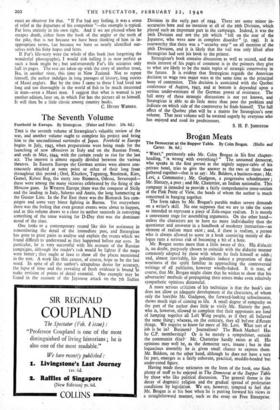The Seventh Volume
Foothold in Europe. By Strategicus. (Faber and Faber. 10s. 6d.) THIS is the seventh volume of Strategicus's valuable review of the war, and another volume ought to complete his project and bring him to the unconditional surrender of Japan. Foothold in Europe begins in July, 1943, when preparations were being made for the launching of new offensives in Italy and on the Russian Front, and ends in May, 1944, with the curtain ready to rise for the last act. The interest is almost equally divided between the various theatres. In Eastern Europe the German armies were almost con- tinuously attacked at some point or other of their long front throughout this period ; Orel, Kharkov, Taganrog, Smolensk, Kiev, Gomel, Krivoi Rog, the entry into Rumania, Odessa, Sevastopol— these were among the many victories celebrated by the firing of the Moscow guns. In Western Europe there was the conquest of Sicily and the landing in Italy, Salerno and Anzio, the long hammering at the Gustav Line. In the Far East there was the Bismarck Sea cam- paigns and some very bitter fighting in Burma. Yet everywhere there was the feeling that even greater events were about to happen, and as this volume draws to a close its author succeeds in conveying something of the tense waiting for D-Day that was the dominant mood of the time.
One looks to a contemporary record like this for assistance in remembering the detail of the immediate past, and Strategicus has gone to great pains to analyse and explain the events which we found difficult to understand as they happened before our eyes. In particular, he is very successful with his account of the Russian campaigns, although the reader's task would be lighter if the maps were better ; they ought at least to show all the places mentioned in the text. A work like this cannot, of course, hope to be the last word. In spite of all the author's scrupulous desire for accuracy, the lapse of time and the revealing of fresh evidence is bound to niake revision of points of detail essential. One example may be found in the account of the Japanese attack on the 7th Indian
Division in the early part of 1944. There are some minor in- accuracies here and no mention at all of the 26th Division, which played such an important part in the campaign. Indeed, it was the 26th Division and not the 5th which " fell on the rear of the Japanese, who were now in complete disorder" (p. 199). It is noteworthy that there was a " security stop " on all mention of the 26th Division, and it is likely that the veil was only lifted after Strategicus had sent his book to the printer.
Strategicus's book contains discussion as well as record, and the main interest of his pages of comment is in the pointers they give to what are likely to be the main topics of strategic controversy in the future. It is evident that Strategicus regards the American decision to wage two major wars at the same time as the principal bone of contention. This decision is associated with the Quebec conference of August, 1943, and at bottom it depended upon a serious under-estimate of the German power of resistance. The full story of these strategic discussions is not yet known, and Strategicus is able to do little more than pose the problem and indicate on which side of the controversy he finds himself. The full effect of the Quebec plan will be a matter for Strategicus's next volume. That next volume will be awaited eagerly by everyone who has enjoyed and used its predecessors.
S. H. F. JOHNSTON






























 Previous page
Previous page